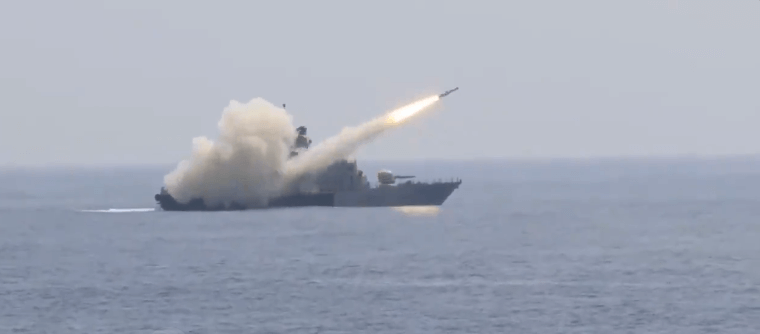To what finally would instil fear inside the hearts of the Chinese, who so far have been afforded a free pass to impose their expansionist policy in regions it has no right to, India announced Australia’s participation in the crucial Malabar Naval Exercise, thereby reuniting all four QUAD members after a period of 13 years.
World’s Most Powerful Naval Power – The US Navy Adds More Muscle To Its Arsenal; Goes Hypersonic
With India’s military already entangled in the fifth-month stand-off with Beijing in Eastern Ladakh, Prime Minister Narendra Modi found common ground with the US, Japan and the Aussies—all nations China has picked a quarrel with—to counter China’s increasing military assertiveness in the Indo-Pacific.
Now, what would be a significant warm-up to the upcoming annual, high-end joint exercise scheduled for next month, the Indian Navy successfully launched its anti-ship missile (AShM) from its Missile Corvette INS Prabal.

INS Prabal, which belongs to the Veer-class corvettes, was sailing in the Arabian Sea when it launched the missile which hit the target – an old ship which was a decommissioned frigate, with deadly accuracy at maximum range and sunk it.
A spokesperson of the Indian Navy tweeted – “AShM launched by Indian Navy Missile Corvette INS Prabal, homes on with deadly accuracy at max range, sinking target ship.”
#AShM launched by #IndianNavy Missile Corvette #INSPrabal, homes on with deadly accuracy at max range, sinking target ship. #StrikeFirst #StrikeHard #StrikeSure #हरकामदेशकेनाम pic.twitter.com/1vkwzdQxQV
— SpokespersonNavy (@indiannavy) October 23, 2020
Started initially between just the navies of India and the United States of America in 1992, the Malabar Naval Exercise was 15 years later expanded to include Japan, Australia and Singapore, in what was a crucial point of the exercise.
Following the birth of the Quadrilateral Initiative in Manila in 2016, November’s exercise marks the first time the four countries will come together.
WATCH: Drunk Russian Soldiers Ram Their Tank Into Airport Wall, Damage Surveillance Systems
The exercise is expected to be held in the Bay of Bengal and the Arabian Sea, with the decision coming at the back of the Quad meeting held in Tokyo at the beginning of the month to discuss China’s aggression.
Moreover, with all four nations ramping up preparations for the joint deployment, New Delhi has chosen not to lag behind with Indian Navy chief Admiral Karambir Singh reviewing the operational preparedness and combat-readiness of his navy’s principal combatants, i.e. warships deployed at sea.
“The Navy would continue maintaining a high-tempo of operations in the coming months in the backdrop of the prevailing security situation,” said Singh, during the review.
Stressing on his navy’s preparedness to adapting and dealing with any future emergency contingencies, Singh stated that the Carrier Battle Group and its combatants had accurate and effective weapon firings.
Admiral Singh was present along with Flag Officer Commanding-in-Chief Western Naval Command, Vice Admiral Ajit Kumar at the Karwar Naval Base in India’s southern Karnataka state, where he was seen interacting with naval personnel.
As stated in a statement issued by the Indian government, Singh had put a huge emphasis on the key issue of repairs, maintenance, spares support and op-logistics for sailing ships in a bid to sharpen their war-fighting capabilities. According to the government statement – “He also reiterated aspects of cyber-security, force protection against terrorist attacks, asymmetric warfare and exhorted all personnel to maintain the highest level of alertness.”
He also reviewed the Carrier Battle Group which comprises of Vikramaditya, destroyers, frigates, corvettes, fleet support ships and integral swing-role fighters and helicopters.
Russia-China Military Alliance – Is This The Chinese Answer To India, US & Their QUAD Aspirations?
Moreover, on his visit to the indigenous guided-missile destroyer Chennai, he also reviewed the demonstrations of air-to-air combat operations, anti-submarine drills and fleet manoeuvres.
According to the government statement, Singh also checked the Carrier Battle Group’s capabilities for integral fleet air defence and strike on his visit to the Fleet Support Ship Deepak and aircraft carrier Vikramaditya.
“The Indian Navy has remained mission-deployed and combat-ready across the IOR (Indian Ocean Region), even through rough seas during the monsoon period, towards maintaining the maritime security of the nation.” said the statement.




